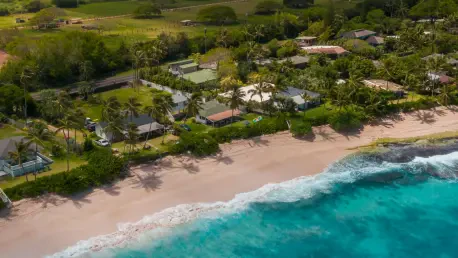In the idyllic landscapes of Hawaiʻi, a troubling trend has emerged that threatens the stability of countless homeowners: insurance companies are increasingly refusing to cover properties deemed too risky due to their proximity to the ocean or the age of their structures. This growing crisis has left many residents scrambling to protect their most valuable asset—their homes—while facing the harsh reality of skyrocketing costs and vanishing options. Reports indicate that insurers are pulling out of entire regions, particularly those prone to natural disasters like hurricanes and rising sea levels. The impact is profound, as homeowners struggle to secure mortgages without coverage, potentially leading to plummeting property values and economic distress in affected communities. This situation raises critical questions about the future of housing in high-risk areas and the role of environmental changes in shaping insurance policies. As the challenges mount, understanding the reasons behind this retreat and exploring potential solutions becomes imperative for those caught in the crosshairs of this insurance dilemma.
1. Rising Risks and Insurer Retreat
The primary driver behind insurers abandoning Hawaiian homes lies in the escalating risks posed by climate-driven disasters. Coastal properties, especially those within a thousand feet of the ocean, are increasingly seen as liabilities due to the heightened threat of hurricanes and sea-level rise. Insurers are drawing rigid boundaries on maps, often ignoring natural barriers like hills that might offer some protection. This blanket approach means that even well-maintained homes near the shore are being denied coverage. Additionally, properties with roofs over 20 years old are frequently rejected, as aging infrastructure is viewed as a financial risk during severe weather events. Companies like State Farm have gone further, refusing to insure single-wall homes across the state, regardless of location. This strategic withdrawal is framed as a necessary step to manage exposure to catastrophic losses, but it leaves homeowners in a precarious position, grappling with the reality of living in a disaster-prone paradise without a safety net.
Another layer of complexity in this insurer retreat is the dramatic rise in coverage costs, which has outpaced inflation in recent years. Data shows that insurance premiums in Hawaiʻi have surged by over 23% in a short span, making policies unaffordable for many residents. This price hike is not merely a reflection of increased risk but also a signal of insurers’ growing reluctance to operate in vulnerable zones. When coverage is available, the stringent criteria—such as mandatory distances from the shore ranging from 300 to 1,000 feet depending on the provider—exclude a significant number of properties. The financial burden falls heavily on homeowners, who must either pay exorbitant rates or risk going uninsured. This trend not only jeopardizes individual families but also destabilizes entire communities, as the lack of affordable insurance can deter potential buyers and depress real estate markets. The ripple effects are felt across the islands, highlighting the urgent need for systemic solutions to address this growing gap in protection.
2. Broader Impacts on Homeowners and Communities
The withdrawal of insurance coverage in Hawaiʻi creates a domino effect that extends far beyond individual households. Without insurance, securing a mortgage becomes nearly impossible, as lenders require protection against potential losses. This barrier to homeownership can lead to a sharp decline in property values, particularly in neighborhoods where coverage has vanished entirely. Towns suffer as residents struggle to sell or repair their homes, leading to economic stagnation and declining community vitality. Uninsured properties also pose a broader risk, becoming financial liabilities in the event of a disaster. A single hurricane could wipe out the savings of families who have invested everything in their homes, leaving them with little recourse for recovery. This vulnerability is especially acute for first-time buyers, who may unknowingly enter markets where insurance is unattainable, only to face devastating consequences when disaster strikes.
Beyond the financial toll, the lack of coverage exacerbates the physical deterioration of homes in high-risk areas. Coastal properties, constantly exposed to ocean spray, experience accelerated wear and tear, requiring frequent and costly repairs. Contractors often refuse to work on such homes due to the heightened risks and lack of insurance backing, leaving owners in a bind. Older structures compound the problem, as outdated building materials and designs are ill-equipped to withstand modern weather extremes. Many residents lack the resources to undertake necessary upgrades, such as replacing aging roofs or reinforcing foundations, further increasing their exposure to loss. This cycle of neglect and risk creates neighborhoods of vulnerable homes, where the absence of insurance not only threatens individual security but also undermines the collective resilience of communities. Addressing these challenges requires innovative approaches to both housing policy and disaster preparedness, tailored to the unique needs of Hawaiian residents.
3. Navigating Solutions in a Changing Landscape
For homeowners caught in this insurance crisis, proactive steps can make a significant difference in mitigating risks and securing some form of protection. Maintaining a property’s condition is crucial—replacing roofs nearing 20 years of age and meticulously documenting all repairs with photos and receipts can strengthen a case for coverage. Creating defensible spaces around homes by clearing flammable vegetation and using fire-resistant materials also helps reduce risk profiles. Additionally, property owners should consider reaching out to local legislators to advocate for stronger building codes and state-supported insurance programs. Hawaiʻi’s Hurricane Relief Fund, recently expanded to include condominium associations, offers a potential model for broader coverage that could be extended to single-family homes. Supporting such initiatives can provide a safety net where private insurers have stepped away, ensuring that residents are not left entirely exposed to the whims of nature.
Another avenue for addressing this crisis lies in collective action and informed decision-making. Homebuyers must prioritize researching insurance availability before committing to a purchase, especially in coastal or fire-prone areas. Requesting a seller’s insurance history and obtaining pre-purchase coverage estimates can prevent future headaches. Meanwhile, supporting leaders who champion clean energy policies is vital, as reducing pollution from fossil fuels can help temper the worsening weather patterns driving these risks. Community organizations also play a key role, with many regions establishing FAIR (Fair Access to Insurance Requirements) plans to offer basic protection after private insurers exit. Joining forces with such groups can amplify advocacy efforts and push for sustainable solutions. Reflecting on past challenges, it’s clear that collaborative efforts paved the way for incremental progress, and looking ahead, these strategies must evolve to balance environmental realities with the fundamental need for secure housing in Hawaiʻi.









